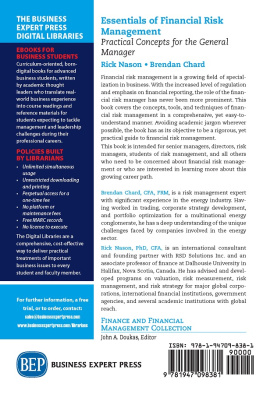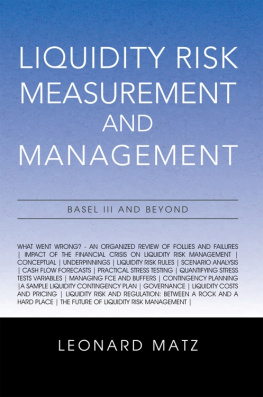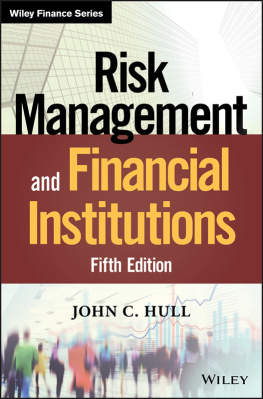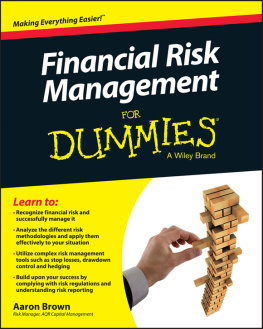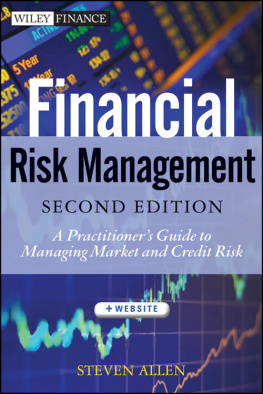Jimmy Skoglund - Financial Risk Management: Applications in Market, Credit, Asset and Liability Management and Firmwide Risk
Here you can read online Jimmy Skoglund - Financial Risk Management: Applications in Market, Credit, Asset and Liability Management and Firmwide Risk full text of the book (entire story) in english for free. Download pdf and epub, get meaning, cover and reviews about this ebook. year: 2015, publisher: Wiley, genre: Business. Description of the work, (preface) as well as reviews are available. Best literature library LitArk.com created for fans of good reading and offers a wide selection of genres:
Romance novel
Science fiction
Adventure
Detective
Science
History
Home and family
Prose
Art
Politics
Computer
Non-fiction
Religion
Business
Children
Humor
Choose a favorite category and find really read worthwhile books. Enjoy immersion in the world of imagination, feel the emotions of the characters or learn something new for yourself, make an fascinating discovery.
- Book:Financial Risk Management: Applications in Market, Credit, Asset and Liability Management and Firmwide Risk
- Author:
- Publisher:Wiley
- Genre:
- Year:2015
- Rating:4 / 5
- Favourites:Add to favourites
- Your mark:
Financial Risk Management: Applications in Market, Credit, Asset and Liability Management and Firmwide Risk: summary, description and annotation
We offer to read an annotation, description, summary or preface (depends on what the author of the book "Financial Risk Management: Applications in Market, Credit, Asset and Liability Management and Firmwide Risk" wrote himself). If you haven't found the necessary information about the book — write in the comments, we will try to find it.
Financial Risk Management presents an in-depth look at banking risk on a global scale, including comprehensive examination of the U.S. Comprehensive Capital Analysis and Review, and the European Banking Authority stress tests. Written by the leaders of global banking risk products and management at SAS, this book provides the most up-to-date information and expert insight into real risk management. The discussion begins with an overview of methods for computing and managing a variety of risk, then moves into a review of the economic foundation of modern risk management and the growing importance of model risk management. Market risk, portfolio credit risk, counterparty credit risk, liquidity risk, profitability analysis, stress testing, and others are dissected and examined, arming you with the strategies you need to construct a robust risk management system. The book takes readers through a journey from basic market risk analysis to major recent advances in all financial risk disciplines seen in the banking industry. The quantitative methodologies are developed with ample business case discussions and examples illustrating how they are used in practice. Chapters devoted to firmwide risk and stress testing cross reference the different methodologies developed for the specific risk areas and explain how they work together at firmwide level. Since risk regulations have driven a lot of the recent practices, the book also relates to the current global regulations in the financial risk areas.
Risk management is one of the fastest growing segments of the banking industry, fueled by banks fundamental intermediary role in the global economy and the industrys profit-driven increase in risk-seeking behavior. This book is the product of the authors experience in developing and implementing risk analytics in banks around the globe, giving you a comprehensive, quantitative-oriented risk management guide specifically for the practitioner.
- Compute and manage market, credit, asset, and liability risk
- Perform macroeconomic stress testing and act on the results
- Get up to date on regulatory practices and model risk management
- Examine the structure and construction of financial risk systems
- Delve into funds transfer pricing, profitability analysis, and more
Quantitative capability is increasing with lightning speed, both methodologically and technologically. Risk professionals must keep pace with the changes, and exploit every tool at their disposal. Financial Risk Management is the practitioners guide to anticipating, mitigating, and preventing risk in the modern banking industry.
Jimmy Skoglund: author's other books
Who wrote Financial Risk Management: Applications in Market, Credit, Asset and Liability Management and Firmwide Risk? Find out the surname, the name of the author of the book and a list of all author's works by series.


